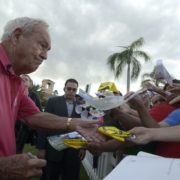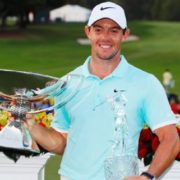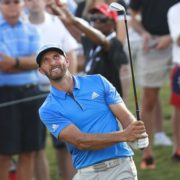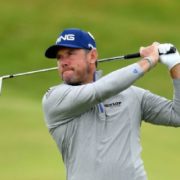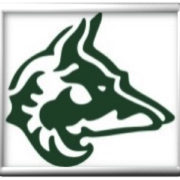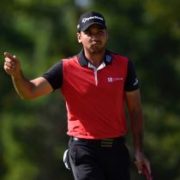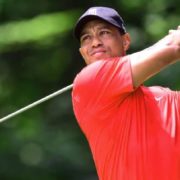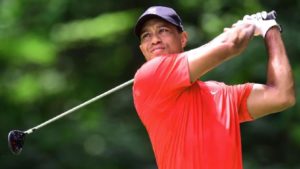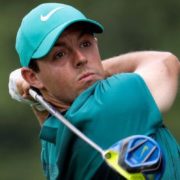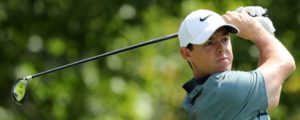Arnold Palmer: ‘The King’ of golf dies at 87
Arnold Palmer was the telegenic golfer who took a staid sport to TV and to the masses
Before accepting the Presidential Medal of Freedomin 2004, Arnold Palmer shared a few laughs with President George W. Bush and gave the commander in chief a few golf tips in the East Room of the White House.
Five years later, when honored with the Congressional Gold Medal, Palmer, who again offered golf tips to some of the most important politicians in the country, jokingly thanked the House and the Senate for being able to agree on something.
After receiving the highest civilian awards given in the United States, Palmer went outside each day, at 1600 Pennsylvania Avenue and the U.S. Capitol, and signed autographs for hundreds of people.
That was Palmer, a man who connected with the masses, who related to kids, the hourly wage employee, the CEO — and Presidents.
Palmer, who died Sunday in Pittsburgh at age 87, according to a statement from the USGA, was the accessible common man who would become the King and lead his own army. Along the way he became one of the sport’s best players and a successful businessman, philanthropist, trailblazing advertising spokesman, talented golf course designer and experienced aviator.
While his approach on the course was not a model of aesthetics — the whirlybird followthrough, the pigeon-toed putting stance — it worked for him. With thick forearms and a thin waist, Palmer had an aggressive risk-reward approach to golf that made for compelling theater. He hit the ball with authority and for distance and ushered in an aggressive, hitch-up-your-trousers, go-for-broke, in-your-face power game rarely seen in the often stoic and staid sport.
Palmer, part of the alluring “Big Three,” with Jack Nicklaus and Gary Player, won 62 titles on the PGA Tour, his last coming in the 1973 Bob Hope Desert Classic. Among those victories were four at the Masters, two at the British Open and one at the U.S. Open. He finished second in the U.S. Open four times, was runner-up three times in the PGA Championship, the only major that eluded him, and was inducted into the World Golf Hall of Fame in 1974.
Palmer became one of the best known sports figures and, at 5-10, 175, a telegenic golfer who burst out of black-and-white television sets across the country in the late 1950s and into the 1960s and took the game to the masses.
“Arnold meant everything to golf. Are you kidding me?” Tiger Woods said. “I mean, without his charisma, without his personality in conjunction with TV — it was just the perfect symbiotic growth. You finally had someone who had this charisma, and they’re capturing it on TV for the very first time.
“Everyone got hooked to the game of golf via TV because of Arnold.”
Friend to Presidents
Palmer won the Vardon Trophy for lowest scoring average on the PGA Tour four times, played on six Ryder Cup teams and was captain twice.
He received virtually every national award in golf and was the “Athlete of the Decade” for the 1960s in a national Associated Press poll. Palmer, who helped found the Golf Channel decades later, also helped usher in the Champions Tour, where he won 10 times, including five majors.
He was a magnetic star who attracted legions of fans who had never played golf as the television boon exploded across the land.
Those fans included U.S. presidents.
Dwight Eisenhower, who loved golf, was one of Palmer’s best friends. Richard Nixonasked Palmer about the Vietnam War. Palmer played golf with both Presidents Bush.
Eisenhower painted Palmer’s picture — as did Norman Rockwell. There is a drink named in Palmer’s honor, as well as an airport, a golf tournament, hospitals, streets, charity initiatives and 19th-hole grill rooms.
And from start to finish, Palmer signed as many autographs, posed for as many pictures, chatted with as many fans in the galleries as any golfer who hit a golf ball.
“There are two things that made golf appealing to the average man — Arnold Palmer and the invention of the mulligan,” actor/comedian and good friend Bob Hope once said.
Palmer was a folk hero with a driver in his hand and a handshake after the round. From 2007 through 2015, he served as the honorary starter for the Masters, creating one of the best moments of the tournament every year on Thursday morning.
“Arnold Palmer was the everyday man’s hero,” Nicklaus said. “From the modest upbringing, Arnold embodied the hard-working strength of America.”
Origins of ‘Arnie’s Army’
Palmer was the oldest of four children born to Deacon and Doris Palmer. He received his first set of golf clubs from his father, who worked at Latrobe Country Club from 1921 until his death in 1976. Growing up near the sixth tee of the club, Palmer learned the grip and the swing from his father, as well as manners, empathy, integrity and respect.
Palmer worked nearly every job at the club before heading to Wake Forest University, where he became one of the top collegiate players. But when his close friend, Bud Worsham, was killed in a car accident, Palmer quit school and enlisted for a three-year hitch in the U.S. Coast Guard.
While stationed in Cleveland, his passion for golf was rekindled. Then, while working as a paint salesman, Palmer quickly got his game back in order and won the 1954 U.S. Amateur Championship. On Nov. 18, 1954, at 25, he turned pro and signed a contract with Wilson Sporting Goods.
His greatest stretch of golf began in 1960 and lasted four years, with Palmer winning six major championships and 29 titles on the PGA Tour. It was in 1960, at the Masters in Augusta, Ga., that a local newspaper coined the phrase “Arnie’s Army,” when soldiers from nearby Camp Gordon followed Palmer. Soon, non-uniformed fans across the land enlisted.
Palmer’s defining moment, one that embedded the word “charge” into the minds of his adoring fans, came in the 1960 U.S. Open at Cherry Hills. Palmer had won the Masters two months earlier, with birdies on the final two holes to edge Ken Venturi by one shot. But Palmer began the final round of the Open seven strokes and 14 players behind and was told by Bob Drum of The Pittsburgh Press that he was too far behind to win.
Angered by the remark, Palmer drove the first green 346 yards away and made the first of four consecutive birdies. He added birdies on the sixth and seventh and shot a final-round 65 to complete the comeback victory.
A month later, Palmer made a pilgrimage to St. Andrews for the British Open, and his presence helped salvage the game’s oldest championship and elevated it back among the game’s best tournaments.
In all, Palmer won eight times in 1960, the year he signed with pioneering sports agent Mark McCormack and quickly became a marketing giant for products ranging from golf equipment to jackets and slacks to automobile oil and rental cars. Palmer became the first professional golfer to earn $1 million for his career. Even into his 80s he was pulling in an estimated $20 million per year.
“Arnold was the epitome of a superstar,” fellow Hall of Famer Raymond Floyd said. “He set the standard for how superstars in every sport ought to be, in the way he has always signed autographs, in the way he has always made time for everyone. On the golf course, all I ever saw was a mass of people. He was able to focus in on everyone in the gallery individually. It wasn’t fake.
“And man, could he play the game.”
Giving back through charities
But as dramatic as his victories were, so, too, were Palmer’s losses in majors.
In 1961 he lost the Masters by one stroke when he made double-bogey on the 72nd hole after accepting premature congratulations from a friend to the right side of the 18th fairway.
Palmer lost three playoffs in the U.S. Open, to Nicklaus in 1962, Julius Boros in 1963 and Billy Casper in 1966, when Palmer blew a seven-shot lead with nine holes to play in regulation.
But the masses never deserted him. Palmer’s appeal was so large, so wide that he even gave origin to a beverage that soon became a hit across the land. One of his favorite drinks was a mixture of iced tea and lemonade.
It is now available in grocery stores and is simply called the Arnold Palmer.
“A guy came up to the bar, and he ordered an Arnold Palmer, and the barman knew what that drink was,” three-time major champion Padraig Harrington recalled about a visit to an Indian restaurant in Orlando in 2009. “Now that’s getting to another level. Think about it, you don’t go up there and order a Tiger Woods at the bar.
“When the guy ordered it, I thought, maybe you could do it in a golf club, but he’s ordered it in a random bar. And the guy, who probably wouldn’t know one end of a club from the other, knew what it was.”
Palmer’s accomplishments were wide spread, his influence wide ranging. He helped raised hundreds of millions more for charities.
In 1989, after Palmer played a major role in a fund-raising drive, the Arnold Palmer Hospital for Children & Women in Orlando opened. The first baby was born within hours after the ribbon cutting. Since, nearly 200,000 children have been born there.
In 2002, Arnie’s Army Battles Prostate Cancer was launched and more than 2,500 tournaments across the country sponsored by the organization have raised more than $3 million for prostate cancer research.
Palmer also left his stamp on developing some 225 courses throughout the world.
“The game has given so much to Arnold Palmer,” Nicklaus said, “but he has given back so much more.”
This was evident when Palmer received the Congressional Gold Medal.
“Arnold Palmer democratized golf, made us think that we, too, could go out and play,” said House Speaker John Boehner, an avid golfer. “He made us think that we could really do anything, really. All we had to do was to go out and try. …
“Arnold, you’ve struck our hearts and our minds, and today your government, your fellow citizens are going to strike a gold medal for you.”
Added Senate Majority Leader Harry Reid: “Golf made you famous, but your tireless efforts to save lives, not your short game, will make you immortal.”
ARNOLD DANIEL “ARNIE” PALMER
Born: Sept. 10, 1929, in the small industrial town of Latrobe in Western Pennsylvania, at the foothills of the Allegheny Mountains
Nickname: The King
Education: Wake Forest, on a golf scholarship, where he was the school’s first individual NCAA champion, in 1949, then the NCAA individual medalist again in 1950; first ACC champion in 1953
Military service: U.S. Coast Guard
Hall of Fame: Inducted in 1974 into the World Golf Hall of Fame, among many halls of fame to honor him
Estimated net worth: $675 million
Playing career: 62 titles on the PGA Tour, including Masters titles in 1958, 1960, 1962, 1964; U.S. Open title in 1960; British Open titles in 1961 and 1962. Vardon Trophy for lowest scoring average on the PGA Tour in 1961, 1962, 1964, 1967. Ryder Cup player in 1961, 1963, 1965, 1967, 1971 and 1973. Last playing captain, in 1963, and captain again in 1975. 10 titles on the Champions Tour, including Senior U.S. Open title in 1981; Senior PGA Championship titles in 1980, 1984; Senior Tournament Players Championship titles in 1984, 1985
Author: A Life Well Played: My Stories, 2106; Arnold Palmer: Memories, Stories, and Memorabilia from a Life on and Off the Course, 2004; Playing by the Rules: All the Rules of the Game, Complete with Memorable Rulings From Golf’s Rich History, 2002; A Golfer’s Life (with James Dodson), 1999; 495 Golf Lessons, 1973; Play Great Golf, 1987; Arnold Palmer’s Complete Book Of Putting (with Peter Dobereiner), 1986; Arnold Palmer’s Best 54 Golf Holes (with Bob Drum), 1977; Go For Broke: My Philosophy of Winning Golf (with William Barry Furlong), 1973; Situation Golf (with Jesus Gutierrez), 1970; My Game and Yours, 1963
Filmography:Return to Campus (1975)
Trivia: In 1971, at 41, Palmer earned the biggest paycheck of his career — $50,000 for winning the Westchester Classic
Quote: “I have a tip that will take five strokes off anyone’s golf game. It’s called an eraser.” — Palmer
By Rachel Shuster
Rory McIlroy rallies from 3 back to win Tour Championship in playoff
ATLANTA — Rory McIlroy holed two shots on the 16th hole at East Lake that made him a most unlikely FedEx Cup champion on Sunday.
The first one he didn’t even see go in.
Three shots behind with three holes to play at the Tour Championship, McIlroy holed a pitching wedge from 137 yards for eagle that gave him the spark he needed to close with a 6-under 64 and join a three-way playoff with the FedEx Cup title riding on the outcome.
“I knew I was right back in the golf tournament,” he said.
Four playoff holes later on the 16th, after Ryan Moore made a par putt from just outside 15 feet, McIlroy knocked in his 15-foot birdie putt to win two trophies that he desperately wanted — the Tour Championship and the FedEx Cup.
“Just to see that ball drop, and everything that’s come together for me this year … to pull it off was really special,” McIlroy said, his voice still hoarse from screaming over so many quality shots, so many clutch moments over the final two hours at East Lake.
McIlroy picked up $11.53 million in one day — the $10 million FedEx Cup bonus and $1.53 million for the Tour Championship, his second victory in three weeks that made him the first player to win four FedEx Cup playoff events.
His only hope was to win the Tour Championship and have Dustin Johnson finish worse than second alone. Johnson closed with a 73 and tied for sixth.
In its 10th year, the FedEx Cup never had a finish like this.
Moore, who might have done enough to earn that last captain’s pick for the Ryder Cup, missed an 8-foot birdie putt by the slimmest of margins on the par-5 18th hole in regulation for a 64. In the playoff, he holed a 10-foot birdie putt with McIlroy facing a 6-foot eagle putt for the victory. McIlroy missed.
Even on the final hole, Moore gave McIlroy everything he had. His chip over a ridge raced well past the hole, and it looked as though McIlroy would only have to two-putt for the victory. Instead, Moore holed another big putt.
“I just wanted to make him earn it for that much money at least,” Moore said. “I wanted him to make the putt. It was nice to get up and make it, but you give a great player like him that many opportunities, and he’s going to make one eventually.”
Chappell had a two-shot lead with two holes to play when he made bogey on the 17th hole — only his third of the week at East Lake — and Moore birdied it in the group ahead of him. Chappell was woefully short on a 20-foot birdie putt on the 18th for the win, and he was eliminated with a par on the first playoff hole when he made par.
They finished at 12-under 268.
Johnson surprisingly was never a factor and he hit too many errant shots on the front nine and never recovered. He still would have won the FedEx Cup had either Moore or Chappell won the tournament, which he said “would have been really cool.”
“It didn’t feel right because I didn’t win the Tour Championship,” Johnson said. “That’s why I was here to win. I knew I controlled my own destiny.”
Johnson was second in the FedEx Cup and received a $3 million bonus.
McIlroy had control of this all along once he got into the playoff, except for one nervous moment.
He looked to put the perfect finish onto his big day when he hit out of the rough and over the water to 6 feet for an eagle putt on the par-5 18th in the first playoff hole. McIlroy was ready to pump his fist until his eagle putt slid by, and he removed his cap in disbelief.
Returning to the 18th, McIlroy missed an 18-foot birdie putt for the win. On the third extra hole, the par-3 15th over the water from 201 yards, McIlroy had to make a 7-foot par putt just to stay in the game.
Nothing was bigger than that birdie at the end. McIlroy stiffened his back, clutched both arms and shouted above the raucous cheers at East Lake.
“I’ve made it no secret that it’s one of the last things I feel like I had left on my golf CV, and I made it a big goal of mine to win it,” McIlroy said. “To be here and to win the FedEx Cup … to play the way I have in the last few weeks to get it done, is very special.”
It was the longest playoff in the 30-year history of the Tour Championship.
Moore had to wait two hours to see if his performance — a 66-64 weekend at East Lake — was worthy of a captain’s pick. Davis Love IIIwas to announce his decision during halftime of the Sunday night NFL game.
Chappell headed into a month off trying to figure out what he has to do to win. He was runner-up for the fourth time this season — twice to Jason Day, the No. 1 player in the world, and once to McIlroy. In those final rounds, Chappell’s scores were 67, 69, 69 and 66.
“I’m proud of the way I fought,” he said. “It just wasn’t enough.”
Dustin Johnson shoots 67, takes 1-shot lead at Tour Championship
ATLANTA — Dustin Johnson is playing better than anyone in the world, and Kevin Chappell can’t wait to watch him at the Tour Championship.
Even if that means having to beat him.
Johnson powered his way down the fairways and occasionally out of the brutal rough at East Lake on Friday for a 3-under 67, giving him a one-shot lead over Chappell and moving him one round closer to the $10 million FedEx Cup prize.
The U.S. Open champion is on a different level at the moment.
Even on a demanding test like East Lake this year — only 10 players remain under par — Johnson is hitting his driver long and straight. His wedge game has gone from a weakness to a strength. A new putter he put in play two weeks ago when he won the BMW Championship is giving him a better feel for alignment.
Small wonder that this was his seventh straight round at 68 or better during the FedEx Cup playoffs.
“The game is never easy. I wish it was,” Johnson said. “Obviously, I’m playing good right now. I’ve got a lot of confidence in my game. Every week, I feel like I bring the same game, which is nice. But I put in a lot of work to get to where I am.”
Johnson was at 7-under 133.
Chappell, one of two players at the Tour Championship who has yet to win on the PGA Tour, was just as solid, even if it doesn’t look as spectacular. He has made only one bogey in 36 holes, quite a feat on a course where the Bermuda rough is so punishing that balls sink to the ground and sometimes can’t be seen from a foot away.
He shot a 68 and will be in the final group of a playoff event for the second time this year.
Kevin Kisner (70) and Hideki Matsuyama (71) were four shots behind, while Rory McIlroy overcame another rough start on the front nine to post a 70. He was in the group five shots behind, which isn’t much of a deficit at the halfway point except for Johnson being the one they have to chase.
If nothing else, Johnson all but eliminated nearly everyone not among the top five seeds vying for the FedEx Cup. McIlroy is No. 6 and still has a chance, though he would have to win the Tour Championship and Johnson would have to finish third.
“I need to win, and I just need someone to play as good as Dustin this week,” McIlroy said.
Jason Day is out of the picture. The world’s No. 1 player withdrew in the middle of a round at the second straight tournament, citing the same nagging back issues that he hopes will be cured by rest.
By Day withdrawing, Johnson won the points-based PGA player of the year award and is likely to win the player vote as PGA Tour player of the year because of his three victories, with perhaps another to follow.
But there is still work ahead of him, and that starts with Chappell.
“I promise you, I’ll be watching Dustin,” Chappell said. “He’s the best player in the world right now, and it’s an opportunity for me to see where my game is. There’s a golf tournament going on, and I have a chance to win that. That’s the ultimate goal. But I also have a chance to see why he’s the best player in the world right now, and I look forward to taking advantage of that opportunity.”
Chappell has been a runner-up three times this season and keeps running into the wrong guys — Kisner at Sea Island, Day at Bay Hill and The Players Championship. He also was in the mix at the TPC Boston until McIlroy pulled away.
“It seems I like going against the hot player at the time,” he said.
Russell Knox matched the low score of the tournament with a 66 that allowed him to get back under par at 1-under 139, along with Justin Thomas, who is still hopeful of a Ryder Cup pick at the end of the week.
Thomas lost a shot when his ball moved right as he set his putter down behind a short par putt on the 11th hole. The PGA Tour reviewed it on videotape and gave him a one-shot penalty under Rule 18-2, the same penalty applied to Johnson at Oakmont in the U.S. Open.
Thomas disagreed with, but accepted, the penalty. His argument was it was not a flat surface and the greens were running fast
“It’s nothing against the rules officials. It’s a god-awful rule,” Thomas said. “It’s very fortunate it didn’t cost Dustin a major championship. I hope it doesn’t cost me anything. I don’t feel like I did anything wrong.”
Mark Russell, the vice president of rules and competition for the tour, said, the wind was light and the ball had been at rest “for quite some time.”
“And the moment that Justin put his club behind the ball and addressed the ball, the ball moved,” he said. “In that situation, the evidence is against the player and he was penalized.”
That left him six shots behind Johnson instead of five. Either way, it’s a tall order for Thomas or anyone to catch Johnson.
Lee Westwood raises Ryder Cup doubts about Davis Love III and Tiger Woods
Leo Spall Deputy Editor
Lee Westwood may have been firing a warning shot or playing mind games as he talked about the prospects of the U.S. and Europe in the Ryder Cup.
As he prepared to make his 10th appearance in the competition at Hazeltine next week, he made it clear that he has not been entirely convinced by the selection and leadership of Davis Love III or vice-captain Tiger Woods.
“His [Love’s] captaincy at Chicago was great for a couple of days,” Westwood said, remembering how Love presided over his country’s rise and fall in 2012 at Medinah, when the team let a 10-6 lead slip in the singles on the final day.
“I don’t know if something went wrong on the Sunday, or the team didn’t play very well for some reason, but that will be in the back of their minds.”
Love was not the favorite to be named America’s captain before his role was confirmed, with Fred Couples fancied by many and the disunity that was obvious under Tom Watson’s leadership at Gleneagles in 2014 still front of mind.
Once the bulk of his team was named, however, the narrative quickly moved on. In terms of the balance of power, the Europeans, for whom the possibility of a rookie horror show has been raised, have been asked a lot by their local media about tackling what has been seen as a strong opposition line up.
Love can boast players such as Jordan Spieth, Phil Mickelson and Dustin Johnson and, while Europe has Rory McIlroy and Westwood, captain Darren Clarke will be heading to Minnesota with six players making their debuts.
Westwood will be one of the experienced players in the team on hand to help rookies such as Chris Wood, Thomas Pieters and Matt Fitzpatrick adjust to the unique Ryder Cup atmosphere, but he hinted the U.S. team might have some teething troubles of its own.
“There seem to have been issues about team spirit and chemistry,” Westwood told ESPN. “Love’s has not picked Bubba Watson and I don’t know what that does for team spirit — he was first outside the points qualification and is No.7 in the world.
“The captain is obviously building them up a lot and making a few interesting decisions. They have have got a strong side and probably are favorites but they haven’t won it for a while and they are playing in front of a home crowd — there is a lot of pressure on them.
“That is going to keep building in the next week or so and by the time the Ryder Cup comes around it is going to be pretty intense for them, the week in Minnesota.
“They have got this task force in place, they are obviously being very serious and doing as much as they can to win the Cup back. There is a lot of pressure on them.”
The role of the teams’ vice-captains — one which many thought Westwood would have been given for Europe had Clarke not made him one of his three picks — is to help players deal with outside influences and issues, keep the team in top form.
But having Woods, a seven-time player with a 13-17-3 record, on the U.S. roster will bring extra attention, even if Love has claimed the 14-time major winner’s strength will be in his contribution to strategy.
“I don’t know what impact there will be from having Tiger around,” Westwood said. “They [the U.S. team] have always struggled to find a partner for Tiger that’s been successful.
“He could have an adverse effect in the team room. People have always seemed to try to do too much when they have partnered him. It might be different if he’s one of the vice-captains — you don’t know.”
Bring Your 4-Some to Foxfire for a September Special Rate!
🍁 Check out our Fall Rates
Register Today for Jack Frost – Jack Daniels Tourney!
Chance to Win 2 – 2017 Memberships ($2,400 value)!
No. 1 golfer Jason Day signs endorsement deal with Nike
Darren Rovell- ESPN Senior Writer
Nike has signed the best golfer in the world — again.
Sources tell ESPN.com that the world’s largest shoe and apparel company has signed Jason Day to wear its shoes and apparel, including its hat.
The move became possible when Nike suddenly announced last month that it was leaving the equipment business. Day, whose contract is up at the end of the year with TaylorMade-Adidas, is happy with his equipment, so he re-signed with TaylorMade. Those who have TaylorMade clubs usually get paired with Adidas shoes and apparel. But that has changed as Adidas, amidst continued consumer pressure in the golf business, is selling its golf businesses.
Terms of the deal were not disclosed, but one source said the No. 1 golfer in the world will get paid north of $10 million a year. Day’s agent Bud Martin of Wasserman did not return a call seeking comment.
Day might not be in the same marketing category as Tiger Woods or Rory McIlroy, but Nike can sell plenty of golf shirts by using Day as a model. Day is the model of consistency that Woods nor McIlroy have been. Not only did he win last year’s PGA Championship, but he has finished in the top 10 in six of the past eight majors.
With Woods out, and McIlroy’s game not up to par, Nike has had to push Brooks Koepka as its next name at retail, but he only has one PGA Tour win.
In Day, Nike hopes to find more relevance on Sunday of the majors. A Nike endorser hasn’t won a major in the past eight, the longest drought since 2003-04. And Tiger’s last PGA Tour came more than three years ago.
Nike agreed to shutter its golf equipment business after it finished fiscal 2016 with $706 million in revenue, its worst year since 2011. While it never achieved significant market share in the equipment business, its golf clothing business is a market leader and profitable.
Tiger Woods targets three events starting with Safeway Open in October
CARMEL, Ind. — Tiger Woods plans to return to competitive golf next month at the Safeway Open, and hopes to add two more events before the end of the year.
Woods, 40, announced on his website Wednesday that he hopes to play the Safeway, formerly known as the Frys.com Open, Oct. 13-16 in Napa, California. It is the first event of the PGA Tour’s 2016-17 season and will be his first tournament in more than a year.
He also said he hopes to play in the European Tour’s Turkish Airlines Open in early November as well as the Hero World Challenge in December, Woods’ annual tournament that benefits the Tiger Woods Foundation.
“I think it’s great,” Phil Mickelson told ESPN on Wednesday. “I’m looking forward to spending time with him at the Ryder Cup. I think that’ll be great motivation for him.
“I’m hoping we can get paired together. That would be really fun. I would love it. It’s great to have him back and hopefully he’s physically able to practice the way he needs.”
Woods, who has held the No. 1 ranking in the world longer than anyone else, has slipped to 711th due to inactivity after undergoing two back procedures in the fall of 2015. He tied for 10th at the Wyndham Championship in August 2015, then had back surgery in mid-September and another procedure in late October.
If Woods plays Oct. 13, it will end a stretch of 416 days between official tournament rounds for him.
“My rehabilitation is to the point where I’m comfortable making plans, but I still have work to do,” Woods said in a statement. “Whether I can play depends on my continued progress and recovery. My hope is to have my game ready to go.
“I’m looking forward to going to California for my foundation event and Safeway. I’m also excited to return to Turkey and Albany [in the Bahamas]. It could be a fun fall. It was difficult missing tournaments that are important to me, but this time I was smart about my recovery and didn’t rush it.”
What shape Woods’ game will be in will be of incredible interest. He suffered through his worst year as a pro in 2015, missing the cut in three major championships. He had swing issues to work through with his coach, Chris Como, that were not helped by injury and inactivity.
“I’m looking forward to seeing him play again, seeing what the state of his game is,” said No. 1-ranked Jason Day, who has become a frequent texting buddy of Woods’ and said he sensed the 14-time major winner was close to a comeback.
“This time I think he’s done it the right way by waiting and not coming back too soon. There’s been a couple of times where I feel like he may have come back too soon and kind of injured himself a little bit more, and that’s what’s kept him out of the game so long. But there’s probably a lot of anticipation to see how the state of his game is and I’m definitely looking forward to watching those tournaments and seeing how his body holds up and how the mental side and obviously the golf side of things hold up as well.”
The Safeway event will be played just two weeks after the Ryder Cup, where Woods will serve as a vice captain for the United States.
“We’re always going to have high expectations because the guy is arguably one of the two greatest players in history if not the greatest,” Mickelson said. “Our expectations of him will always be high. It doesn’t mean given all the health issues and challenges that he’s faced… it doesn’t mean that’s fair.”
The Turkish Airlines Open (Nov. 3-6) is the first of three European Tour events known as the Final Series. Woods played the tournament in 2013 and tied for third. He is likely getting an appearance fee to compete.
The Hero World Challenge, to be played Dec. 1-4 in the Bahamas, is an 18-player event that invites players based on the world rankings and major championships. Woods has an exemption as tournament host.
Rory McIlroy rallies, vaults up Deutsche Bank leaderboard
NORTON, Mass. — The bad news for Rory McIlroy happened Friday, as he played his first three holes of the Deutsche Bank Championship opening round in 4-over par. The good news is that he’s bounced back in a big way, playing the next 51 holes in 13 under, including a third-round 5-under 66 on Sunday that moved him into contention for his first PGA Tour win of the season.
“The way I’m looking at it is, how good a tournament would this be to win, being 4 over through three,” he said. “It’s a great opportunity to do something that I’ve never done before. I’ve never started a tournament like that and went on to win it, so it’s a great opportunity to try and overcome a little bit of adversity to start with and then get into it.”
McIlroy has overcome his share of adversity already during this tournament. In addition to five bogeys, he has carded a double-bogey and a triple-bogey. Those have been counteracted by an impressive 17 birdies and an eagle that was nearly a double-eagle.
After backing off his second shot on the par-5 18th hole multiple times due to sudden wind gusts, McIlroy hit a 4-iron shot that bounced on the front of the green, rolled directly at the hole and lipped out.
“It was worth the wait,” he laughed. “I had to back off the shot twice because the wind was gusting and I didn’t know if I had enough club in the end. I hit a 4 iron as good as I could and buttoned it. It looked good for a while.”
As to whether it would’ve been an albatross or a double-eagle, McIlroy remained firm: “Definitely albatross. I’m still European. I play for the blue team.”
Speaking of playing for the blue team, McIlroy should have European Ryder Cup fans breathing easier with his putting display so far this week.
One week after switching to a Scotty Cameron putter and formalizing a working relationship with short-game guru Phil Kenyon, McIlroy is more than 4 strokes better on the greens than the field, according to the strokes gained putting statistic.
“I think I’m No. 1 on tour strokes gained off the tee, No. 2 strokes gained tee to green, so that stuff has been there all year,” he explained. “Even the approach shots haven’t been up to the standard I would like them to be, but even around the green I’ve been OK.
“It’s just been the putting that’s really let me down. I’m really happy with that; I’m happy with how I’ve held on. I’m happy with how I converted a few of the chances I had yesterday and today, and feel like if I can just keep that going, and build on the momentum that I have.”
Latest News
 Foxfire Golf Course UpdateAugust 11, 2020 - 7:09 pm
Foxfire Golf Course UpdateAugust 11, 2020 - 7:09 pm Major questions about Tiger, Brooks and more with Masters one month awayMarch 10, 2020 - 8:52 pm
Major questions about Tiger, Brooks and more with Masters one month awayMarch 10, 2020 - 8:52 pm How often should you replace your irons?September 29, 2019 - 10:09 am
How often should you replace your irons?September 29, 2019 - 10:09 am Gary Woodland’s journey to U.S. Open championJune 17, 2019 - 5:37 am
Gary Woodland’s journey to U.S. Open championJune 17, 2019 - 5:37 am Cantlay (64) Rallies From 4 Back To Win MemorialJune 3, 2019 - 12:42 pm
Cantlay (64) Rallies From 4 Back To Win MemorialJune 3, 2019 - 12:42 pm
Promotions
Club Events
Business Hours
Contact Us:
Foxfire Golf Club
389 Canterbury Road
Commercial Point, OH. 43116
Our Location
389 Canterbury Road
Commercial Point, OH. 43116
Pro Shop
(614) 224-3694


